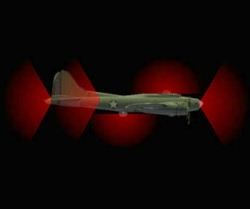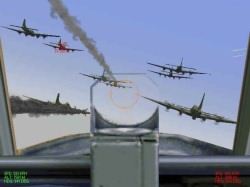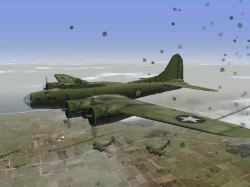| Strategy in EAW
by Microprose |
||||
|
"I dove from about 800 meters above them, approaching at high speed, and fired at the far left aircraft in the rear flight, continuing fire until point blank range. Finally, large pieces of metal flew off the Hurricane. As I shot past the aircraft, I found myself in the middle of the enemy squadron, which was flying in stepped formation.
 B17 Weapons Coverage
I immediately attacked the right-hand aircraft of the leading flight of three. Again, metal panels broke off; the aircraft nosed over and dove earthward, ablaze. The remaining English pilots were so startled that none as much as attempted to get on my tail; rather, the entire formation scattered and dove away."
Lesson Learned: The element of surprise can be psychologically unbalancing to the victims of the attack, and can sometimes place even a numerically superior enemy on the defensive. Also, when Galland pulled up from his initial attack inside the enemy squadron, his aggression in the face of overwhelming odds maintained and enhanced the shock value of his initial attack. Had he tried to simply break off at that point, it is much more likely that he would have been pursued. Sometimes the best defense is a good offense.

"We attacked the enemy bombers in pairs, going in with great bravado…But at first the attacks were all broken off much too early--as those great 'barns' grew larger and larger our people were afraid of colliding with them…The next time I went in I thought: get in much closer, keep going, keep going. Then I opened up, starting with his motors on the port wing. By the third such firing run the two port engines were burning well and I had shot the starboard outer motor to smithereens." |

"To fight against twenty Russians that want to have a bite of one, or also against Spitfires, is a joy. And one doesn't know that life is not certain. But the curve into seventy Fortresses lets all the sins of one's life pass before one's eyes. And when one has convinced oneself, it is still more painful to force to it every pilot in the wing, down to the last young newcomer." Lessons Learned: The B-17 is the most difficult aircraft to destroy in EAW. These bombers can take a lot of punishment and still keep flying. You have to get in close and hit hard to down them, and doing so puts your own aircraft at considerable risk. Also, you must consider the vulnerability of new and inexperienced replacement pilots when tackling these hazardous missions, which come more frequently as the war progresses. "There were about 200 of us attacking the 200 bombers (B-17's) but there was also the fighter escort above them. We were going for the bombers. When we made our move, the P-47's began to dive on us and it was a race to get to the bombers before getting intercepted. I was already close and about 600 feet above and coming straight on; I opened fire with the twenties at 500 yards. At 300 yards I opened fire with the thirties. It was a short burst, maybe ten shells from each cannon, but I saw the bomber explode and begin to burn. I flashed over him at about 50 feet and then did a chandelle. When I turned around I was about a thousand feet above and behind them, and was suddenly mixed in with American fighters… By now I had only three fighters with me--my lead Schwarm--the others had split away in the attack. We flew south, ahead for a few seconds, preparing for another strike at the bombers and then, coming from above, I saw them…
There were ten P-47's and four of us and we were all turning as hard as we could, as in a Lufbery. I was able to turn tighter and was gaining. I pulled within 80 yards of the P-47 ahead of me and opened fire. I hit him quickly and two of the others got one each…I called on the radio for an emergency dive to get away and we all rolled over and did a Split-S and dived with full throttle." Lesson Learned: A good leader has high situational awareness and constantly evaluates the implications of the tactical situation. He knows when to press an attack and when to disengage to fight another day. You never want to push a bad situation, such as the odds Eder encountered in this engagement. The victories his Schwarm achieved in the latter part of this engagement were defensive, not offensive in nature. They were orchestrated simply to stay alive and lessen the odds against them until a suitable escape opportunity could be found. Go to Page Four
|
|||
|
Copyright © 1997 - 2000 COMBATSIM.COM, INC. All Rights Reserved. Last Updated May 26th, 1999 |
||||
